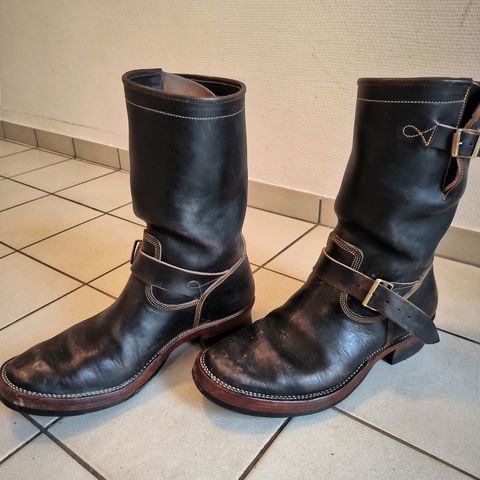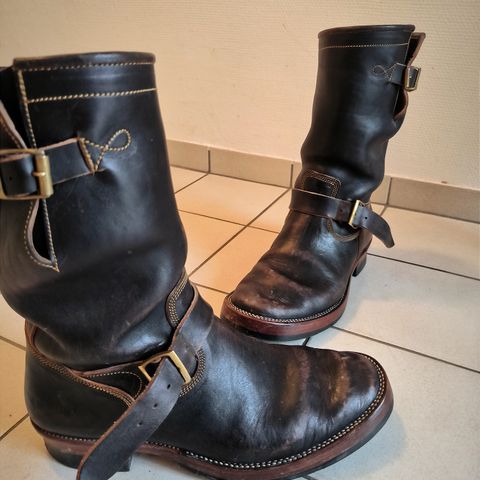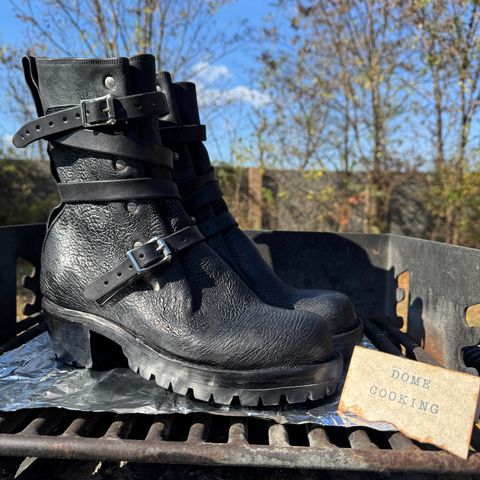About
Conceria Cloe Black Horsebutt is a vegetable-tanned horse leather produced by Conceria Cloe, an Italian tannery located in Ponte a Égola, Tuscany. The black finish is achieved through an overdyed treatment that creates a teacore effect, revealing brown undertones as the leather wears and develops patina over time.
About
Conceria Cloe Black Horsebutt is a vegetable-tanned horse leather produced by Conceria Cloe, an Italian tannery located in Ponte a Égola, Tuscany. The black finish is achieved through an overdyed treatment that creates a teacore effect, revealing brown undertones as the leather wears and develops patina over time.
This leather is cut from the hind section of the horse, a layer positioned above shell cordovan, and is known for its dense fiber structure and soft, gummy texture. The vegetable tanning process, performed using traditional Tuscan pit-tanning methods, results in a leather with high oil content that contributes to its distinctive aging characteristics.
Production and Tanning
Conceria Cloe produces black horsebutt through a slowly pit-tanned vegetable tanning process. The traditional Tuscan methods create a full vegetable-tanned construction with no pigment involved in the base leather. The black color is applied as an overdyed finish on top of the natural vegetable-tanned horsebutt.
The tanning process achieves a very soft temper while maintaining the leather's structural integrity. The resulting leather features a subtle grain variation with a dry, matte touch in its initial state. This contrasts with the lustrous, almost metallic shine it develops through wear and patina development.
Physical Characteristics
The leather exhibits several distinctive physical properties that make it suitable for demanding footwear applications. Its dense fiber structure provides durability while the soft, gummy, and stretchy texture allows for comfortable wear from the initial break-in period.
Conceria Cloe black horsebutt is available in various thicknesses to accommodate different construction requirements. Natural horsebutt versions typically range from 1.8 to 2.0 mm thick, though the leather can be produced at 2.5 mm thickness, equivalent to 5.5 to 6.5 oz. The material can also be split to thicknesses ranging from 0.6 to 0.8 mm up to 1.6 to 1.8 mm, providing flexibility for different applications.
Aging and Patina Development
The high oil content inherent to vegetable-tanned horsebutt makes this leather particularly prone to patina development. Over time and with regular wear, the surface develops a lustrous, almost metallic shine that contrasts with its initially dry, matte appearance.
The overdyed black finish creates what is known as a teacore effect. As the black surface layer wears through use, brown undertones from the underlying vegetable-tanned leather become visible. This gradual revelation of color creates a distinctive aged appearance that varies based on wear patterns and exposure.
Applications in Heritage Footwear
Conceria Cloe black horsebutt has been adopted by several heritage footwear manufacturers for premium boot construction. Indonesian bootmaker Sagara uses the material in their Valiant and Legatant models, pairing it with 270º Norwegian Storm Welt construction and the Morgan Last structured design. Spanish bootmaker Meermin has also incorporated the leather into their Norvegese service boots.
The leather's characteristics make it particularly suitable for Norwegian and storm welt construction methods. Its combination of durability and soft temper provides what manufacturers describe as lightweight breaking in from day one, while maintaining long-term structural integrity. Some variations of Conceria Cloe black horsebutt are marketed under the name Superlux horsebutt.
References
"Horse Culatta - Cloe S.R.L". Mill Hand Made. Retrieved October 23, 2025.
"CLOE HORSE BUTT FENG – OLIVE". Belts Production. Retrieved October 23, 2025.
"New Valiant". Sagara Bootmaker. Retrieved October 23, 2025.































































